SKODA OCTAVIA 2014 3.G / (5E) Owner's Manual
Manufacturer: SKODA, Model Year: 2014, Model line: OCTAVIA, Model: SKODA OCTAVIA 2014 3.G / (5E)Pages: 280, PDF Size: 35.53 MB
Page 111 of 280
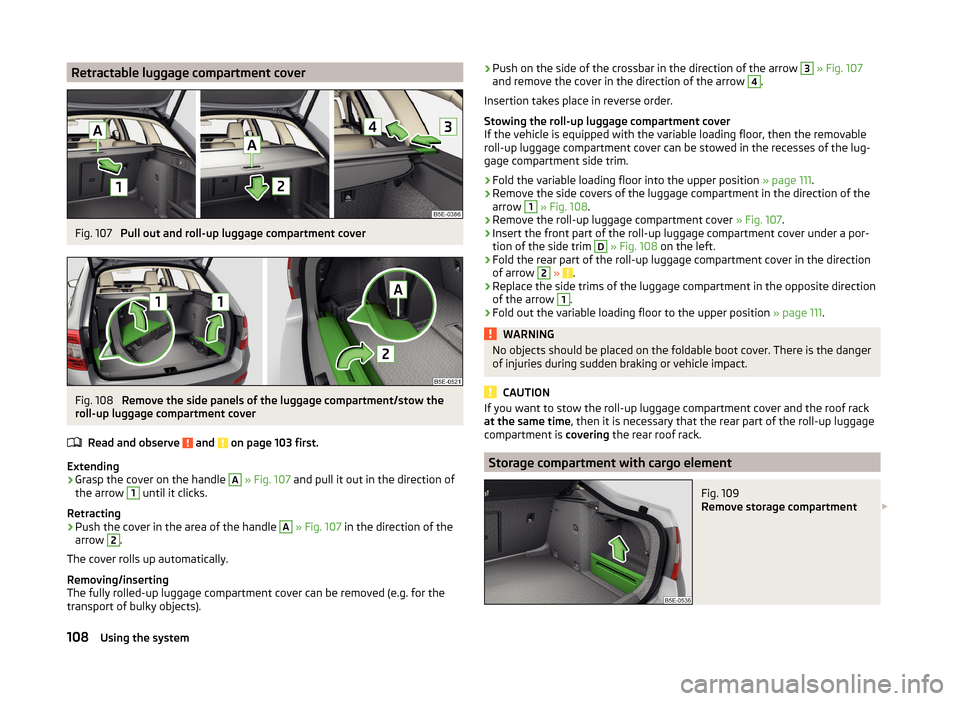
Retractable luggage compartment coverFig. 107
Pull out and roll-up luggage compartment cover
Fig. 108
Remove the side panels of the luggage compartment/stow the
roll-up luggage compartment cover
Read and observe
and on page 103 first.
Extending
›
Grasp the cover on the handle
A
» Fig. 107 and pull it out in the direction of
the arrow
1
until it clicks.
Retracting
›
Push the cover in the area of the handle
A
» Fig. 107 in the direction of the
arrow
2
.
The cover rolls up automatically.
Removing/inserting
The fully rolled-up luggage compartment cover can be removed (e.g. for the
transport of bulky objects).
› Push on the side of the crossbar in the direction of the arrow 3
» Fig. 107
and remove the cover in the direction of the arrow 4.
Insertion takes place in reverse order.
Stowing the roll-up luggage compartment cover
If the vehicle is equipped with the variable loading floor, then the removable roll-up luggage compartment cover can be stowed in the recesses of the lug-
gage compartment side trim.›
Fold the variable loading floor into the upper position » page 111.
›
Remove the side covers of the luggage compartment in the direction of the
arrow
1
» Fig. 108 .
›
Remove the roll-up luggage compartment cover » Fig. 107.
›
Insert the front part of the roll-up luggage compartment cover under a por-
tion of the side trim
D
» Fig. 108 on the left.
›
Fold the rear part of the roll-up luggage compartment cover in the direction
of arrow
2
» .
›
Replace the side trims of the luggage compartment in the opposite direction
of the arrow
1
.
›
Fold out the variable loading floor to the upper position » page 111.
WARNINGNo objects should be placed on the foldable boot cover. There is the danger
of injuries during sudden braking or vehicle impact.
CAUTION
If you want to stow the roll-up luggage compartment cover and the roof rack
at the same time , then it is necessary that the rear part of the roll-up luggage
compartment is covering the rear roof rack.
Storage compartment with cargo element
Fig. 109
Remove storage compartment
108Using the system
Page 112 of 280

Fig. 110
Removing cargo element/example on how to mount the load by
means of the cargo element
Read and observe
and on page 103 first.
The storage compartment with cargo element may be located on either of thetwo sides of the luggage compartment, depending on the equipment variant.
Remove the storage compartment cover
›
Remove the storage compartment cover in the direction of the ar-
row » Fig. 109 .
Secure load
›
Remove the cargo element (part of the storage compartment cover) in the di-
rection of the arrow » Fig. 110-
.
›
Secure the cargo element onto the floor of the luggage compartment with
Velcro » Fig. 110 -
.
CAUTION
■
The storage compartment is designed for storing small objects of up to
2.5 kg. in weight in total.■
The cargo element is designed for attaching objects with a maximum total
weight of 8 kg.
■
When using the storage compartment, take care not to damage it or the lug-
gage compartment lining.
Storage compartments under the floor coveringFig. 111
Lift floor covering/storage compartments under the floor cover-
ing
Read and observe
and on page 103 first.
The storage compartments are located under the floor covering of the luggagecompartment in vehicles without a spare wheel.
Use
›
Dividing the luggage compartment with variable loading floor » page 112.
›
Remove the fog floor covering in the direction of the arrow » Fig. 111.
›
Fix the hook
A
to the top edge of the variable loading floor.
It is possible also to store objects with larger heights in the storage compart-
ments
B
, thereby using the maximum height of the luggage compartment.
CAUTION
■ The storage compartment is designed for storing small objects of up to 15 kg.
in weight in total.■
Do not stored any sharp objects in the storage compartments.
■
Do not load the storage compartments at specific points or they may be
damaged.
■
Place the objects carefully into the storage compartments to avoid damage
to the compartments.
109Transporting and practical equipment
Page 113 of 280
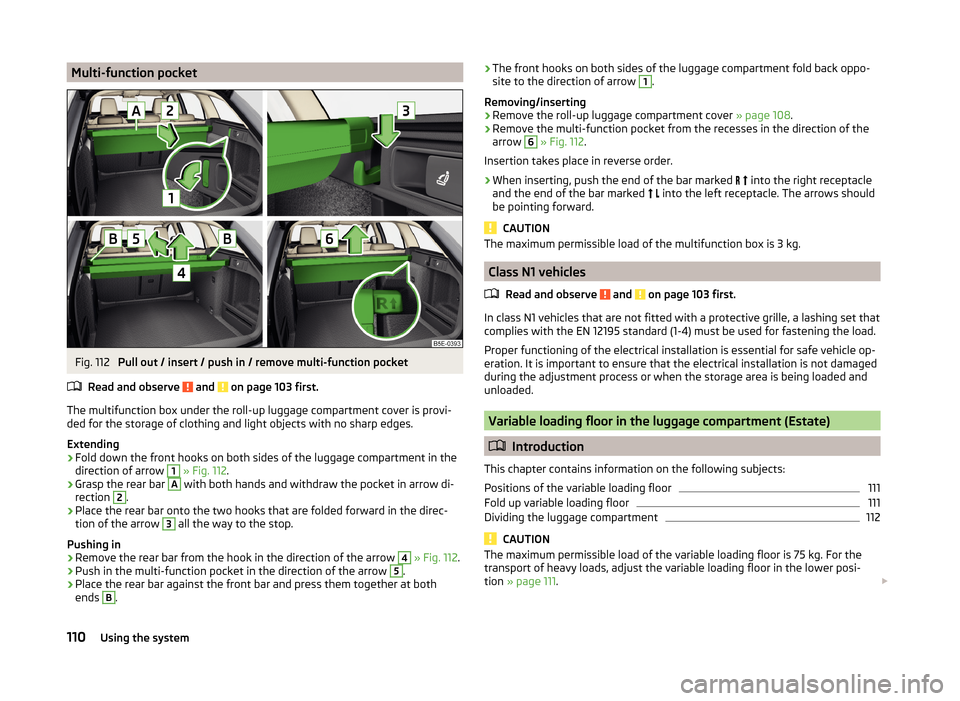
Multi-function pocketFig. 112
Pull out / insert / push in / remove multi-function pocket
Read and observe
and on page 103 first.
The multifunction box under the roll-up luggage compartment cover is provi- ded for the storage of clothing and light objects with no sharp edges.
Extending
›
Fold down the front hooks on both sides of the luggage compartment in the
direction of arrow
1
» Fig. 112 .
›
Grasp the rear bar
A
with both hands and withdraw the pocket in arrow di-
rection
2
.
›
Place the rear bar onto the two hooks that are folded forward in the direc-
tion of the arrow
3
all the way to the stop.
Pushing in
›
Remove the rear bar from the hook in the direction of the arrow
4
» Fig. 112 .
›
Push in the multi-function pocket in the direction of the arrow
5
.
›
Place the rear bar against the front bar and press them together at both
ends
B
.
› The front hooks on both sides of the luggage compartment fold back oppo-
site to the direction of arrow 1.
Removing/inserting›
Remove the roll-up luggage compartment cover » page 108.
›
Remove the multi-function pocket from the recesses in the direction of the
arrow
6
» Fig. 112 .
Insertion takes place in reverse order.
›
When inserting, push the end of the bar marked
into the right receptacle
and the end of the bar marked
into the left receptacle. The arrows should
be pointing forward.
CAUTION
The maximum permissible load of the multifunction box is 3 kg.
Class N1 vehicles
Read and observe
and on page 103 first.
In class N1 vehicles that are not fitted with a protective grille, a lashing set that
complies with the EN 12195 standard (1-4) must be used for fastening the load.
Proper functioning of the electrical installation is essential for safe vehicle op-
eration. It is important to ensure that the electrical installation is not damaged
during the adjustment process or when the storage area is being loaded and
unloaded.
Variable loading floor in the luggage compartment (Estate)
Introduction
This chapter contains information on the following subjects:
Positions of the variable loading floor
111
Fold up variable loading floor
111
Dividing the luggage compartment
112
CAUTION
The maximum permissible load of the variable loading floor is 75 kg. For the
transport of heavy loads, adjust the variable loading floor in the lower posi-
tion » page 111 . 110Using the system
Page 114 of 280
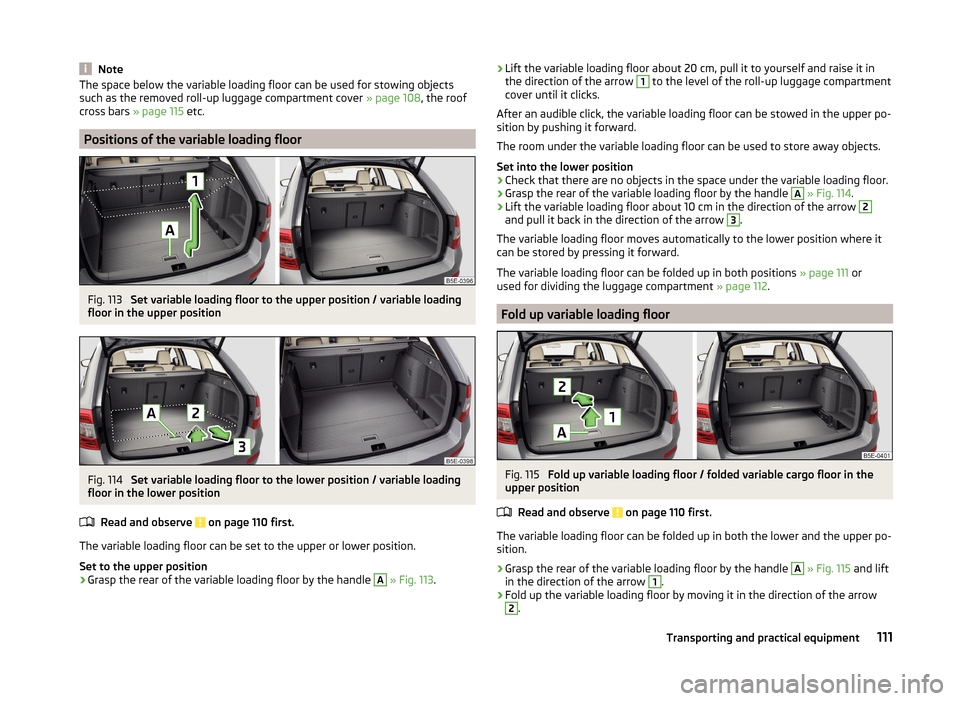
NoteThe space below the variable loading floor can be used for stowing objects
such as the removed roll-up luggage compartment cover » page 108, the roof
cross bars » page 115 etc.
Positions of the variable loading floor
Fig. 113
Set variable loading floor to the upper position / variable loading
floor in the upper position
Fig. 114
Set variable loading floor to the lower position / variable loading
floor in the lower position
Read and observe
on page 110 first.
The variable loading floor can be set to the upper or lower position.
Set to the upper position
›
Grasp the rear of the variable loading floor by the handle
A
» Fig. 113 .
›Lift the variable loading floor about 20 cm, pull it to yourself and raise it in
the direction of the arrow 1 to the level of the roll-up luggage compartment
cover until it clicks.
After an audible click, the variable loading floor can be stowed in the upper po-
sition by pushing it forward.
The room under the variable loading floor can be used to store away objects.
Set into the lower position›
Check that there are no objects in the space under the variable loading floor.
›
Grasp the rear of the variable loading floor by the handle
A
» Fig. 114 .
›
Lift the variable loading floor about 10 cm in the direction of the arrow
2
and pull it back in the direction of the arrow
3
.
The variable loading floor moves automatically to the lower position where it
can be stored by pressing it forward.
The variable loading floor can be folded up in both positions » page 111 or
used for dividing the luggage compartment » page 112.
Fold up variable loading floor
Fig. 115
Fold up variable loading floor / folded variable cargo floor in the
upper position
Read and observe
on page 110 first.
The variable loading floor can be folded up in both the lower and the upper po-
sition.
›
Grasp the rear of the variable loading floor by the handle
A
» Fig. 115 and lift
in the direction of the arrow
1
.
›
Fold up the variable loading floor by moving it in the direction of the arrow
2
.
111Transporting and practical equipment
Page 115 of 280
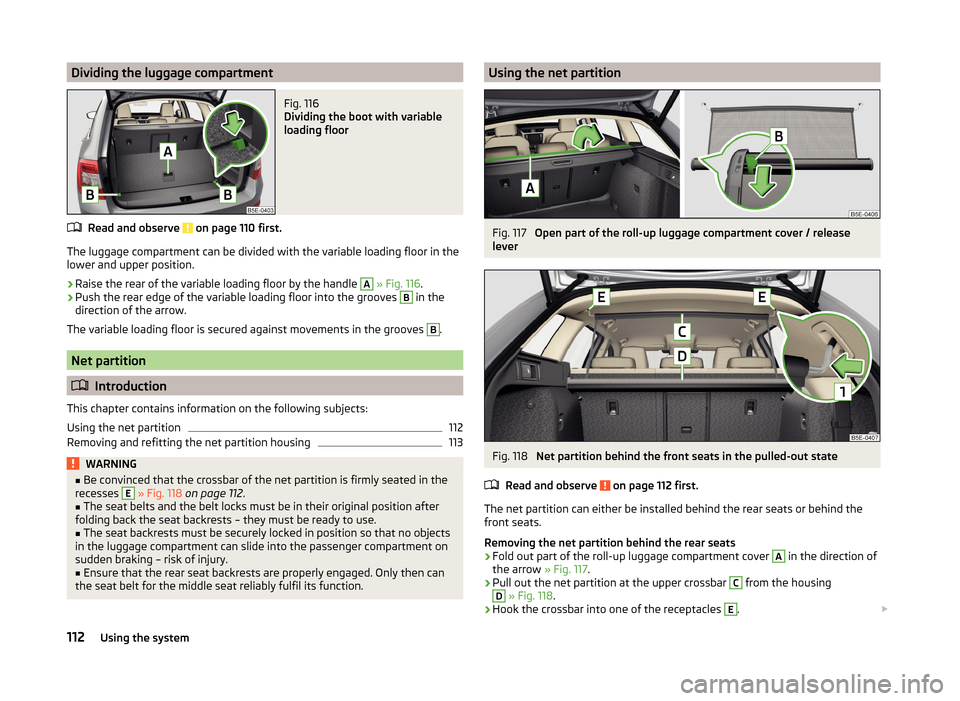
Dividing the luggage compartmentFig. 116
Dividing the boot with variable
loading floor
Read and observe on page 110 first.
The luggage compartment can be divided with the variable loading floor in the lower and upper position.
›
Raise the rear of the variable loading floor by the handle
A
» Fig. 116 .
›
Push the rear edge of the variable loading floor into the grooves
B
in the
direction of the arrow.
The variable loading floor is secured against movements in the grooves
B
.
Net partition
Introduction
This chapter contains information on the following subjects:
Using the net partition
112
Removing and refitting the net partition housing
113WARNING■ Be convinced that the crossbar of the net partition is firmly seated in the
recesses E » Fig. 118 on page 112 .■
The seat belts and the belt locks must be in their original position after
folding back the seat backrests – they must be ready to use.
■
The seat backrests must be securely locked in position so that no objects
in the luggage compartment can slide into the passenger compartment on
sudden braking – risk of injury.
■
Ensure that the rear seat backrests are properly engaged. Only then can
the seat belt for the middle seat reliably fulfil its function.
Using the net partitionFig. 117
Open part of the roll-up luggage compartment cover / release
lever
Fig. 118
Net partition behind the front seats in the pulled-out state
Read and observe
on page 112 first.
The net partition can either be installed behind the rear seats or behind the front seats.
Removing the net partition behind the rear seats
›
Fold out part of the roll-up luggage compartment cover
A
in the direction of
the arrow » Fig. 117.
›
Pull out the net partition at the upper crossbar
C
from the housing
D
» Fig. 118 .
›
Hook the crossbar into one of the receptacles
E
.
112Using the system
Page 116 of 280
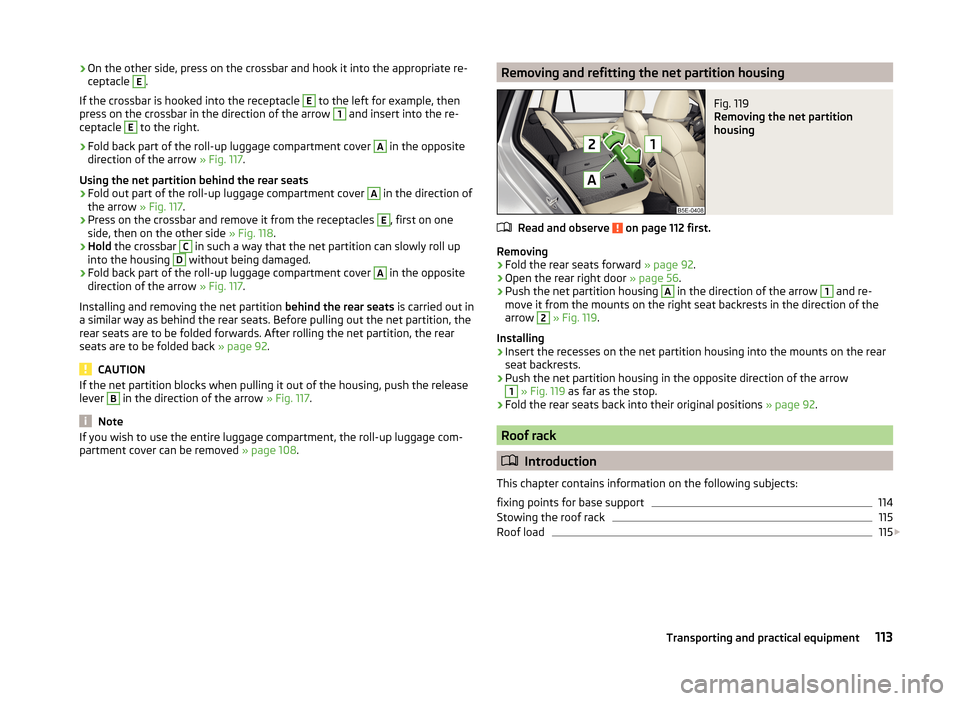
›On the other side, press on the crossbar and hook it into the appropriate re-
ceptacle E.
If the crossbar is hooked into the receptacle E
to the left for example, then
press on the crossbar in the direction of the arrow
1
and insert into the re-
ceptacle
E
to the right.
›
Fold back part of the roll-up luggage compartment cover
A
in the opposite
direction of the arrow » Fig. 117.
Using the net partition behind the rear seats
›
Fold out part of the roll-up luggage compartment cover
A
in the direction of
the arrow » Fig. 117.
›
Press on the crossbar and remove it from the receptacles
E
, first on one
side, then on the other side » Fig. 118.
›
Hold the crossbar
C
in such a way that the net partition can slowly roll up
into the housing
D
without being damaged.
›
Fold back part of the roll-up luggage compartment cover
A
in the opposite
direction of the arrow » Fig. 117.
Installing and removing the net partition behind the rear seats is carried out in
a similar way as behind the rear seats. Before pulling out the net partition, the
rear seats are to be folded forwards. After rolling the net partition, the rear
seats are to be folded back » page 92.
CAUTION
If the net partition blocks when pulling it out of the housing, push the release
lever B in the direction of the arrow » Fig. 117.
Note
If you wish to use the entire luggage compartment, the roll-up luggage com-
partment cover can be removed » page 108.Removing and refitting the net partition housingFig. 119
Removing the net partition
housing
Read and observe on page 112 first.
Removing
›
Fold the rear seats forward » page 92.
›
Open the rear right door » page 56.
›
Push the net partition housing
A
in the direction of the arrow
1
and re-
move it from the mounts on the right seat backrests in the direction of the
arrow
2
» Fig. 119 .
Installing
›
Insert the recesses on the net partition housing into the mounts on the rear
seat backrests.
›
Push the net partition housing in the opposite direction of the arrow
1
» Fig. 119 as far as the stop.
›
Fold the rear seats back into their original positions » page 92.
Roof rack
Introduction
This chapter contains information on the following subjects:
fixing points for base support
114
Stowing the roof rack
115
Roof load
115
113Transporting and practical equipment
Page 117 of 280

WARNING■The items which you transport on the roof rack must be reliably attached
– risk of accident!■
Always secure the load with appropriate and undamaged lashing straps
or tensioning straps.
■
Distribute the load evenly over the roof rack system.
■
When transporting heavy objects or objects which take up a large area on
the roof rack system, the handling of the car may change as a result of the
displacement of the centre of gravity. The style of driving and speed must
therefore be adapted to the current circumstances.
■
Avoid abrupt and sudden driving/braking manoeuvres.
■
The permissible roof load, permissible axle loads and gross permissible
weight of the vehicle must not be exceeded under any circumstances – risk
of accident!
CAUTION
■ Only roof racks from the ŠKODA Original Accessories range should be used.■When dealing with roof rack systems, the installation instructions supplied
with the roof luggage rack system must be observed.■
On models fitted with a sliding/tilting roof, ensure that the sliding/tilting roof
does not strike any items of luggage transported on the roof.
■
Ensure that the luggage compartment lid does not hit the roof load when
opened.
■
The height of the vehicle changes after mounting a roof luggage rack system
and the load that is secured to it. Compare the vehicle height with available
clearances, such as underpasses and garage doors.
■
Always remove the roof luggage rack system before entering an automated
car wash.
■
Ensure the roof aerial is not impaired by the secured load.
For the sake of the environment
The increased aerodynamic drag results in a higher fuel consumption.fixing points for base supportFig. 120
Attachment points
Read and observe
and on page 114 first.
Installation location of the attachment points for base support » Fig. 120
Front attachment points
Rear attachment points
Perform the assembly and disassembly according to the enclosed instructions.
CAUTION
Observe the information regarding the assembly and disassembly in the en-
closed instructions.AB114Using the system
Page 118 of 280
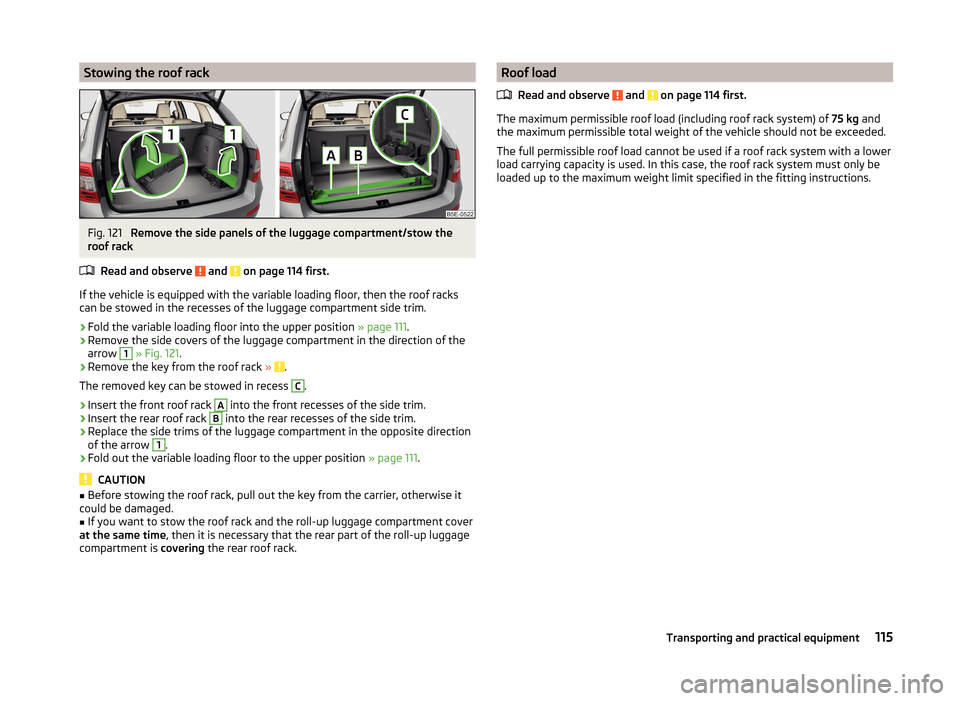
Stowing the roof rackFig. 121
Remove the side panels of the luggage compartment/stow the
roof rack
Read and observe
and on page 114 first.
If the vehicle is equipped with the variable loading floor, then the roof racks
can be stowed in the recesses of the luggage compartment side trim.
›
Fold the variable loading floor into the upper position » page 111.
›
Remove the side covers of the luggage compartment in the direction of the
arrow
1
» Fig. 121 .
›
Remove the key from the roof rack » .
The removed key can be stowed in recess
C
.
›
Insert the front roof rack
A
into the front recesses of the side trim.
›
Insert the rear roof rack
B
into the rear recesses of the side trim.
›
Replace the side trims of the luggage compartment in the opposite direction
of the arrow
1
.
›
Fold out the variable loading floor to the upper position » page 111.
CAUTION
■
Before stowing the roof rack, pull out the key from the carrier, otherwise it
could be damaged.■
If you want to stow the roof rack and the roll-up luggage compartment cover
at the same time , then it is necessary that the rear part of the roll-up luggage
compartment is covering the rear roof rack.
Roof load
Read and observe
and on page 114 first.
The maximum permissible roof load (including roof rack system) of 75 kg and
the maximum permissible total weight of the vehicle should not be exceeded.
The full permissible roof load cannot be used if a roof rack system with a lower
load carrying capacity is used. In this case, the roof rack system must only be
loaded up to the maximum weight limit specified in the fitting instructions.
115Transporting and practical equipment
Page 119 of 280
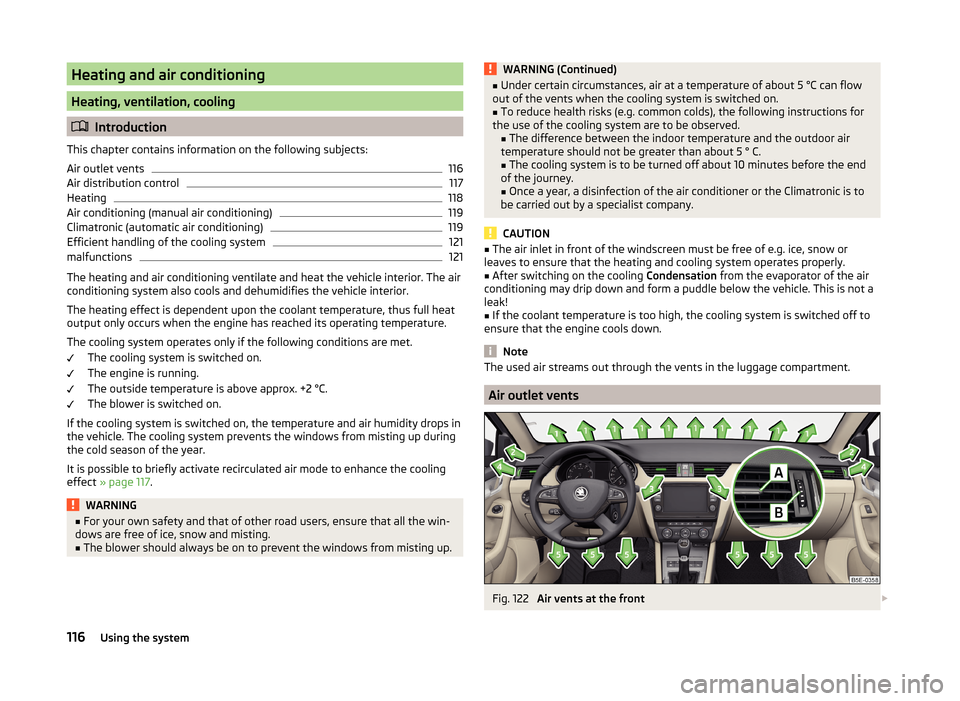
Heating and air conditioning
Heating, ventilation, cooling
Introduction
This chapter contains information on the following subjects:
Air outlet vents
116
Air distribution control
117
Heating
118
Air conditioning (manual air conditioning)
119
Climatronic (automatic air conditioning)
119
Efficient handling of the cooling system
121
malfunctions
121
The heating and air conditioning ventilate and heat the vehicle interior. The air
conditioning system also cools and dehumidifies the vehicle interior.
The heating effect is dependent upon the coolant temperature, thus full heat
output only occurs when the engine has reached its operating temperature.
The cooling system operates only if the following conditions are met. The cooling system is switched on.
The engine is running.
The outside temperature is above approx. +2 °C.
The blower is switched on.
If the cooling system is switched on, the temperature and air humidity drops in
the vehicle. The cooling system prevents the windows from misting up during
the cold season of the year.
It is possible to briefly activate recirculated air mode to enhance the cooling
effect » page 117 .
WARNING■
For your own safety and that of other road users, ensure that all the win-
dows are free of ice, snow and misting.■
The blower should always be on to prevent the windows from misting up.
WARNING (Continued)■ Under certain circumstances, air at a temperature of about 5 °C can flow
out of the vents when the cooling system is switched on.■
To reduce health risks (e.g. common colds), the following instructions for
the use of the cooling system are to be observed. ■The difference between the indoor temperature and the outdoor air
temperature should not be greater than about 5 ° C.
■ The cooling system is to be turned off about 10 minutes before the end
of the journey.
■ Once a year, a disinfection of the air conditioner or the Climatronic is to
be carried out by a specialist company.
CAUTION
■ The air inlet in front of the windscreen must be free of e.g. ice, snow or
leaves to ensure that the heating and cooling system operates properly.■
After switching on the cooling Condensation from the evaporator of the air
conditioning may drip down and form a puddle below the vehicle. This is not a
leak!
■
If the coolant temperature is too high, the cooling system is switched off to
ensure that the engine cools down.
Note
The used air streams out through the vents in the luggage compartment.
Air outlet vents
Fig. 122
Air vents at the front
116Using the system
Page 120 of 280
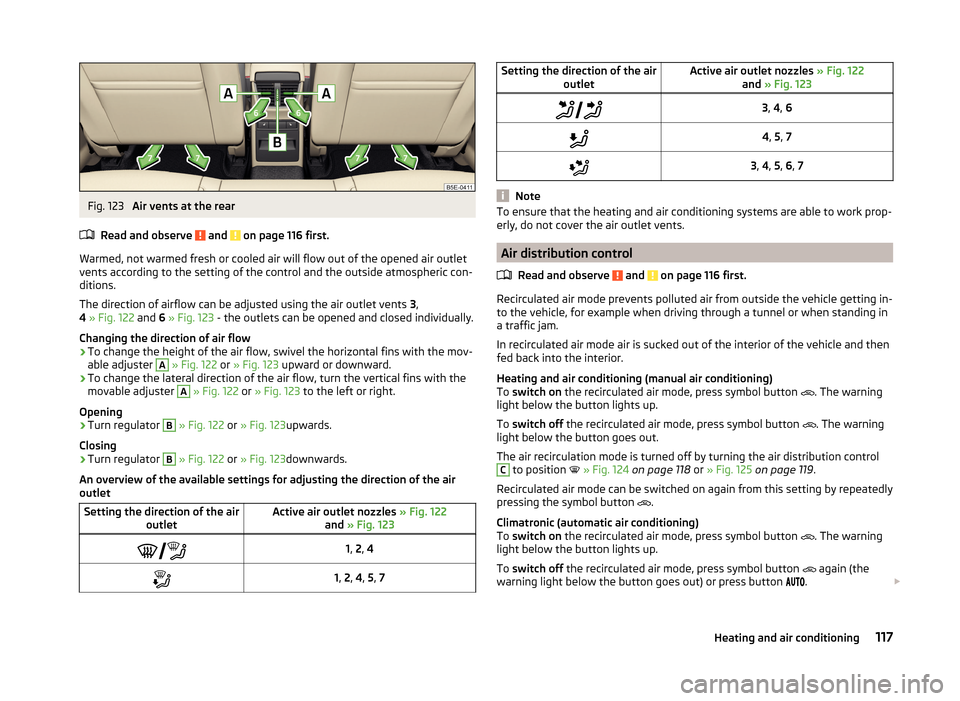
Fig. 123
Air vents at the rear
Read and observe
and on page 116 first.
Warmed, not warmed fresh or cooled air will flow out of the opened air outlet
vents according to the setting of the control and the outside atmospheric con-
ditions.
The direction of airflow can be adjusted using the air outlet vents 3,
4 » Fig. 122 and 6 » Fig. 123 - the outlets can be opened and closed individually.
Changing the direction of air flow
›
To change the height of the air flow, swivel the horizontal fins with the mov-
able adjuster
A
» Fig. 122 or » Fig. 123 upward or downward.
›
To change the lateral direction of the air flow, turn the vertical fins with the
movable adjuster
A
» Fig. 122 or » Fig. 123 to the left or right.
Opening
›
Turn regulator
B
» Fig. 122 or » Fig. 123 upwards.
Closing
›
Turn regulator
B
» Fig. 122 or » Fig. 123 downwards.
An overview of the available settings for adjusting the direction of the air
outlet
Setting the direction of the air outletActive air outlet nozzles » Fig. 122
and » Fig. 123 1, 2 , 41, 2 , 4 , 5 , 7Setting the direction of the air
outletActive air outlet nozzles » Fig. 122
and » Fig. 1233, 4 , 64 , 5 , 73 , 4 , 5 , 6 , 7
Note
To ensure that the heating and air conditioning systems are able to work prop-
erly, do not cover the air outlet vents.
Air distribution control
Read and observe
and on page 116 first.
Recirculated air mode prevents polluted air from outside the vehicle getting in-
to the vehicle, for example when driving through a tunnel or when standing in
a traffic jam.
In recirculated air mode air is sucked out of the interior of the vehicle and then
fed back into the interior.
Heating and air conditioning (manual air conditioning)
To switch on the recirculated air mode, press symbol button
. The warning
light below the button lights up.
To switch off the recirculated air mode, press symbol button
. The warning
light below the button goes out.
The air recirculation mode is turned off by turning the air distribution control
C
to position
» Fig. 124 on page 118 or » Fig. 125 on page 119 .
Recirculated air mode can be switched on again from this setting by repeatedly
pressing the symbol button .
Climatronic (automatic air conditioning)
To switch on the recirculated air mode, press symbol button
. The warning
light below the button lights up.
To switch off the recirculated air mode, press symbol button
again (the
warning light below the button goes out) or press button .
117Heating and air conditioning